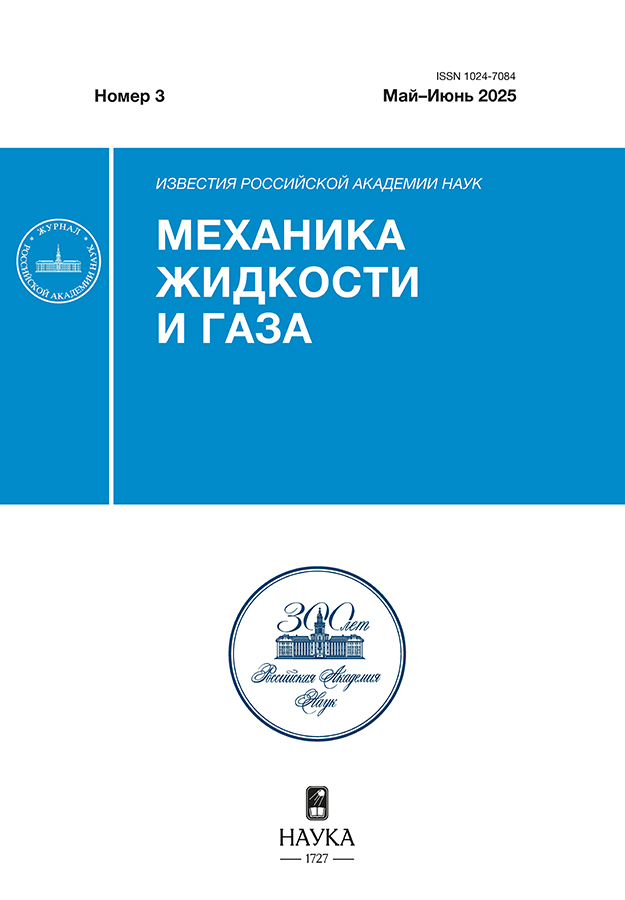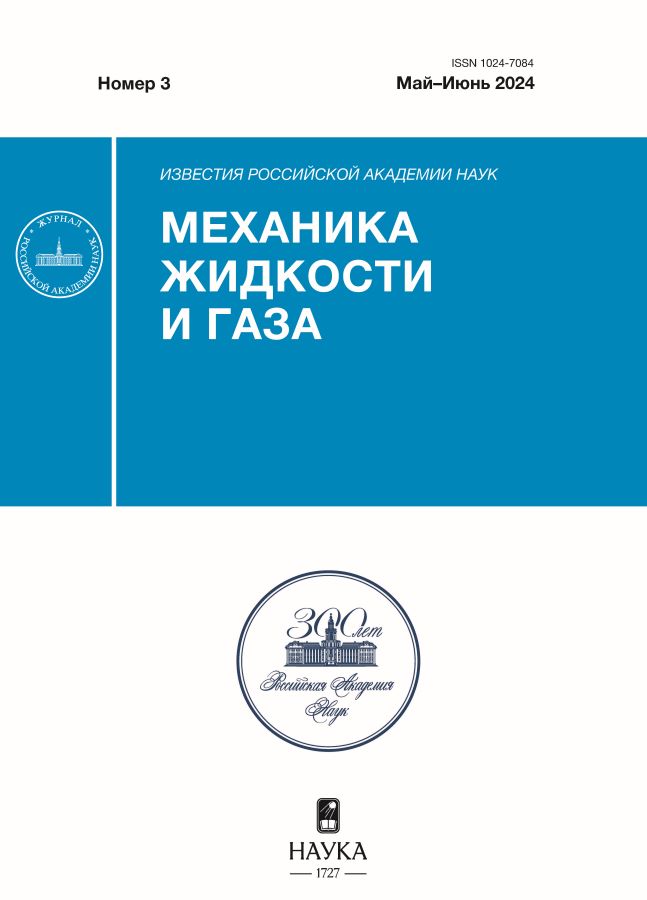Simulation of the Development of Richtmyer-Meshkov Instability and Transition to Developed Turbulence
- Authors: Zmushko V.V.1, Polishchuk M.I.1, Razin A.N.1, Sinel’nikova A.A.1, Shcherbakov A.N.1
-
Affiliations:
- Russian Federal Nuclear Center – All-Russian Scientific Research Institute of Experimental Physics (RFNC–VNIIEF)
- Issue: No 3 (2024)
- Pages: 75-96
- Section: Articles
- URL: https://rjmseer.com/1024-7084/article/view/682513
- DOI: https://doi.org/10.31857/S1024708424030068
- EDN: https://elibrary.ru/PFUKLI
- ID: 682513
Cite item
Abstract
A criterion for estimating the instant of transition from the stage of development of the Richtmyer–Meshkov instability to developed turbulence on rough contact interfaces of layered gas systems is proposed. A number of laboratory experiments are simulated. In the first series of experiments, the Richtmyer–Meshkov instability arises on two contact interfaces of a thin gas layer after passage of a shock wave. In the experiments, a thin layer (corrugated gas curtain) is formed by pumping a heavy gas (SF6) through a nozzle block across an air-filled shock tube. In the second series of experiments, the shock wave passes across the contact interface of two gases of different densities (air-SF6 and He-SF6 layerings) perturbed along a sinusoid. In this series of experiments, the end face of the tube is either connected to the atmosphere or closed by a rigid wall. Development of the Richtmyer–Meshkov instability and transition to turbulent mixing are simulated using the implicit large eddy (ILES) method by means of the MIMOZA technique. A comparison with the available experimental information is made.
Full Text
About the authors
V. V. Zmushko
Russian Federal Nuclear Center – All-Russian Scientific Research Institute of Experimental Physics (RFNC–VNIIEF)
Author for correspondence.
Email: VVZmushko@vniief.ru
Russian Federation, Sarov
M. I. Polishchuk
Russian Federal Nuclear Center – All-Russian Scientific Research Institute of Experimental Physics (RFNC–VNIIEF)
Email: MIPolischuk@vniief.ru
Russian Federation, Sarov
A. N. Razin
Russian Federal Nuclear Center – All-Russian Scientific Research Institute of Experimental Physics (RFNC–VNIIEF)
Email: ANRazin@vniief.ru
Russian Federation, Sarov
A. A. Sinel’nikova
Russian Federal Nuclear Center – All-Russian Scientific Research Institute of Experimental Physics (RFNC–VNIIEF)
Email: AnASinelnikova@vniief.ru
Russian Federation, Sarov
A. N. Shcherbakov
Russian Federal Nuclear Center – All-Russian Scientific Research Institute of Experimental Physics (RFNC–VNIIEF)
Email: ANScherbakov@vniief.ru
Russian Federation, Sarov
References
- Лебо И.Г., Тишкин В.Ф. Исследование гидродинамической неустойчивости в задачах лазерного термоядерного синтеза методами математического моделирования. М.: ФИЗМАТЛИТ, 2006. 304 с.
- Янилкин Ю.В., Стаценко В.П., Козлов В.И. Математическое моделирование турбулентного перемешивания в сжимаемых средах. Саров: Изд-во ФГУП РФЯЦ-ВНИИЭФ, 2009. 507 с.
- Невмержицкий Н.В. Гидродинамические неустойчивости и турбулентное перемешивание веществ. Лабораторное моделирование. Саров: Изд-во ФГУП РФЯЦ-ВНИИЭФ, 2018. 246 с.
- Разин А.Н. Моделирование турбулентного перемешивания в газовых слойках. Саров: Изд-во ФГУП РФЯЦ-ВНИИЭФ, 2020. 290 с.
- Grinstein F.F., Margolin L.G., Rider W.J. (editor) Impliсit large eddy simulation: computing turbulent fluid dynamics, Cambridge university press. 2007.
- Бодров Е.В., Змушко В.В., Невмержицкий Н.В., Разин А.Н., Сеньковский Е.Д., Сотсков Е.А. Расчетно-экспериментальное исследование развития турбулентного перемешивания в газовой слойке при прохождении ударной волны // Изв. РАН. МЖГ. 2018. № 3. С. 54–62. https://doi.org/10.7668/S0568528118030052
- Янилкин Ю.В. Двумерное численное моделирование опыта по перемешиванию в трехслойной газовой системе с условием прилипания на стенках ударной трубы // ВАНТ. Сер. Математическое моделирование физических процессов. 2022. Вып. 2. С. 17–26.
- Большакова А.Э., Змушко В.В., Невмержицкий Н.В., Разин А.Н., Сеньковский Е.Д., Сотсков Е.А. Численное моделирование развития неустойчивости на контактных границах трехслойной газовой системы. Сравнение с экспериментальными данными // ПМТФ. 2021. Т. 62. № 1. С. 43–54. https://doi.org/10.15372/PMTF20210105
- Змушко В.В., Разин А.Н., Синельникова А.А. Влияние начальной шероховатости контактных границ на развитие неустойчивости после прохождения ударной волны // ПМТФ. 2022. Т. 63. № 3. С. 34–42. https://doi.org/10.15372/PMTF20220304
- Змушко В.В., Разин А.Н., Синельникова А.А., Щербаков А.Н. Влияние интенсивности ударной волны на развитие неустойчивости на шероховатых контактных границах трехслойной газовой системы // ЖВММФ. 2023. Т. 63. № 3. С. 89–101. https://doi.org/10.31857/S0044466923030134, EDN: DZYLAC
- Разин А.Н., Змушко В.В., Синельникова А.А. Влияние диссипативных погрешностей методики МИМОЗА на скорость изменения кинетической энергии при распаде вихря Тейлора-Грина // ВАНТ. Сер. Математическое моделирование физических процессов. 2023. Вып. 1. С. 29–41.
- Янилкин Ю.В., Бондаренко Ю.А., Гончаров Е.А., Гужова А.Р., Колобянин В.Ю., Софронов В.Н., Стаценко В.П. Тесты для гидрокодов, моделирующих ударноволновые течения в многокомпонентных средах. Саров: Изд-во ФГУП РФЯЦ-ВНИИЭФ, 2018.
- Balakumar B.J., Orlicz G.C., Tomkins C.D., Prestridge K.P. Simultaneous particle-image velocimetry-planar laser-induced fluorescence measurements of Richtmyer-Meshkov instability growth in a gas curtain with and without reshock // Physics of Fluids. 2008. V.20. 124103.
- Orlicz G.C., Balakumar B.J., Tomkins C.D., Prestridge K.P. A Mach number study of the Richtmyer-Meshkov instability in a varicose, heavy-gas curtain // Physics of Fluids.2009. V. 21(6). 064102.
- Orlicz G.C., Balasubramanian S., Prestridge K.P. Incident shock Mach number effects on Richtmyer-Meshkov mixing in a heavy gas layer // Physics of Fluids. 2013.V. 25. № 11. 114101.
- Змушко В.В., Плетенёв Ф.А., Сараев В.А., Софронов И.Д. Методика решения трехмерных уравнений газовой динамики в смешанных лагранжево-эйлеровых координатах // ВАНТ. Сер. Методики и программы численного решения задач математической физики. 1988. Вып.1. С. 22–27.
- Софронов И.Д., Афанасьева Е.А., Винокуров О.А., Воропинов А.И., Змушко В.В., Плетенев Ф.А., Рыбаченко П.В., Сараев В.А., Соколова Н.В., Шамраев Б.Н. Комплекс программ МИМОЗА для решения многомерных задач механики сплошной среды на ЭВМ “Эльбрус-2” // ВАНТ. Сер. Математическое моделирование физических процессов. 1990. Вып.2. С. 3–9.
- Zmushko V.V. Computation of convective flows and their realization in MIMOZA code // International Workshop “New Models of Numerical Codes for Shock Wave Processes in Condensed Media” / Oxford / September 15–19. 1997.
- Ладагин В.К., Пастушенко А.М. Об одной схеме расчета газодинамических течений // Численные методы механики сплошной среды. 1977. Т. 8. № 2. С. 66–72.
- Youngs D.L. Time dependent multi-material flow with large distortion / Numerical methods for fluid dynam. Ed by K.W. Morton and J.H. Baines eds.. Academic press, 1982.
- Dimotakis P.E. The mixing transition in turbulent flows // J. Fluid Mech. 2000. V.409. P. 69–98
- Zhou Ye, Remington B.A., Robey H.F., Cook A.W., Glendinning S.G., Dimits A., Buckingham A.C., Zimmerman G.B., Burke E.W., Peyser T.A., Cabot W., Eliason D. Progress in understanding turbulent mixing induced by Rayleigh-Taylor and Richtmyer-Meshkov instabilities // Physics of Plasmas. 2003. 10(5). P. 1883–1896.
- Монин А.Е., Яглом А.М. Статистическая гидромеханика. Ч. 2. М: Наука, 1967.
- Tanaka Y., Nakajima M., Kubota H., Makita T. Viscosity of SF6+N2 and SF6+He gaseous mixtures // J. Chemical Engineering of Japan. 1980. V.13. № 2.
- Gowardhan A.A., Grinstein F. Numerical simulation of Richtmyer-Meshkov instabilities in shocked gas curtains // J. of Turbulence. 2011. 12(43). P. 1–24.
- Jacobs J.W., Krivets V.V. Experiments on the late-time development of single-mode Richtmyer-Meshkov instability // Physics of Fluids. 17. 034105. 2005.
- Motl B., Oakley J., Ranjan D., Weber C., Anderson M., Bonazza R. Experimental validation of a Richtmyer-Meshkov scaling law over large density ratio and shock strength ranges // Physics of Fluids. 21. 126102. 2009.
- Richtmyer R.D. Taylor instability in shock acceleration of compressible fluids // Commun. Pure Appl. Math. 13. 297. 1960.
Supplementary files
































